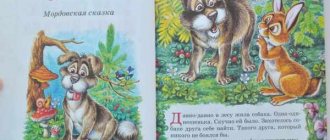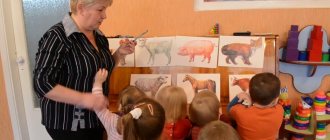Topic of the week: “Pets”
Children should know:
- names of domestic animals: cow, cat, dog, goat, horse, pig, sheep, ram, horse; - names of cubs and family: calf, kitten, puppy, foal, lamb, piglet, kid; — the concept of “pets”; - the external signs of each, what they eat, how they voice; - where they live, what benefits they bring;
Expanding children's vocabulary:
Nouns : animal, horse, horse, foal, foals, cow, bull, calf, calves, sheep, ram, lamb, lambs, goat, goat, kid, kids, pig, hog, piglet, piglets, dog, dog, puppy, puppies, cat, cat, kitten, kittens, head, muzzle, ears, body, four paws (legs), horns, wool, tail, house, man, benefit, wool, meat, milk, leather, herd, farm, stable, hay, swill, horns, mane, hooves, barnyard, cowshed, kennel, booth, stable, pigsty, pasture, sheepfold, milkmaid, machine milking operator, pig farm, groom, shepherd, shepherd.
Adjectives : necessary, useful, kind, herbivorous, domestic, fluffy, smooth, horned, fierce, affectionate, evil, stubborn;
Verbs : start, feed, look after, protect, love, neigh, moo, bleat, meow, grunt, bark, meow.
Finger gymnastics “Burenushka”.
Give me milk, Buryonushka, (children show the cow’s “horns”, bend their index finger and little finger) At least a drop on the bottom. Kittens are waiting for me, little kids. Give them a spoonful of cream (they bend one finger at a time, starting with the little fingers, on both hands) A little cottage cheese, on both hands. Butter, curdled milk, milk for porridge. Cow's milk gives everyone health! (The cow’s “horns” are shown again)
Grammatical structure of speech
— Didactic exercise “One-many” (formation of plural nouns):
cat - cats - many cats foal - foals - many foals dog - dogs - many dogs kitten - kittens - many kittens pig - pigs - many pigs horse - horses - many horses
— Didactic exercise “Call it affectionately” (formation of nouns with diminutive suffixes in singular and plural):
cow - cow horse - horse cat - kitty sheep - sheep dog - dog sheep - sheep ram - lamb
— Didactic exercise “Count to five” (coordination of nouns with numerals):
One cat, two cats, three cats, four cats, five cats One cat, ..., five cats One dog, ..., five dogs One horse, ..., five horses One sheep, ..., five sheep One cow, two cows, three cows , four cows, five cows
— Didactic exercise “Guess who it is?” :
Guards, chews, barks? – the dog grunts, digs? - The pig neighs, runs, jumps? – Does the horse meow, lap, scratch? – cat Moos, chews, walks? - cow
— Didactic exercise “Who has who?” (word formation exercise):
Goat - goat - kids Cow - bull - calves Pig - boar - piglets Horse - horse - foals Dog - dog - puppies Sheep - ram - lambs Cat - cat - kittens Goat - goat - kids
— Didactic exercise “Who gives what voice?”:
The horse neighs. The sheep bleats. The dog barks and growls. The cat purrs and meows. The pig grunts. The cow moos.
— Didactic exercise “Whose? Whose? Whose?" (formation of possessive adjectives):
Dog kennel. - Whose kennel? - dog. Milk from goats, cows. - Whose milk? - goat, cow. Horns of ram, cow, goat. - Whose horns? - lamb, cow, goat. Tail of a horse, cat, dog. -Whose tail? - horse, cat, dog. Hooves of a cow, horse. -Whose hooves? - cows, horses. Goat beard. - Whose beard? - goat. Cat paws. -Whose paws? – feline.
— Didactic exercise “Who lives where?” (use of the nominative case of nouns):
lives in a barn (who?) - a cow lives in a pigsty (who?) - a pig lives in a kennel (who?) - a dog lives in a barn (who?) - a sheep, a ram lives in a barn (who?) - a goat
— Didactic exercise “Continue the sentences”:
The dog barks, gnaws bones, guards... (house). The horse neighs, grazes... (in the meadow). The cat purrs, catches mice... (in the basement).
— Didactic exercise “Correct the sentence”:
The dog cackles at strangers. — The dog barks at strangers. The cow gives wool. - The cow gives milk. The cat pecks at the milk. - The cat laps the milk. The pig growls in the trough. - The pig is splashing in the trough. The cat grunts on the sofa. – The cat is purring on the sofa.
— Didactic exercise Compose a story about a pet according to plan.
This is a goat, a domestic animal. The body is covered with fluffy hair. The head is small, elongated, with protruding horns. Loves green grass. Produces tasty meat, milk, wool. A goat lives in a barn, a stable.
Why do we get animals?
Man domesticated wild animals thousands of years ago, and from that moment on, the life of our ancestors was closely connected with them. However, it should be noted that the role of animals in people’s lives has changed greatly: from using them as a living instrument to literally elevating them to the status of an equal member of the family.
Modern families most often get animals to enjoy communicating with them, as a fashion or status element, for protection or use in work, often, consciously or not, animals replace the missing family member.
Usually people are confused if you ask them why they need a pet. This happens because our emotional impulses are often difficult to describe in words, but the situation with animals is exactly this: we get them to expand our social circle, not to feel lonely, to have someone nearby in whom we can be confident, to feel love and gratitude to you.
Often families answer that they got an animal for their child. We believe that caring for a pet will teach a child responsibility and make him more sociable and kind. But is this so and under what conditions will real friendship develop between a child and his pet?
Advice from a speech therapist to parents
Show the child (if possible living) domestic animals - a cat, a dog, a cow, a goat, a horse, a pig, a sheep. Discuss the external signs of each, talk about what they eat.
Tell children how pets benefit people.
Read poems, stories about pets, look at illustrations.
Sample questions for children:
— Why are these animals called “domestic”? — What benefits does (horse, cow, sheep, etc.) bring to people? - Why does a horse have hooves on its legs? - Why can’t you hear the cat walking?
Things to think about before getting a pet
First of all, you need to understand that you are getting a pet not only for your child, but also for yourself. If the child is still small, then most of the responsibilities for caring for the pet will fall on your shoulders. Think about whether you are ready to take on a new burden of responsibility and new worries. By getting an animal, you are getting a new family member who will require not only a lot of attention and time, but also certain financial expenses. It is also worth considering whether your living conditions allow you to have a pet.
If you live in your own home, you can have any animal. And in a small apartment, even fish may not find a suitable place. If you are still not ready to keep a pet, then it is better not to get one. Otherwise, when you decide to give the animal away, it can be a big tragedy for both the child and the pet.
Dangers from Pets
Animals can be dangerous to children. First of all, it's an allergy. If a child or someone in the house is prone to allergic reactions, it is not recommended to get an animal.
Also, many animals are carriers of various infections that a child can very easily catch. Therefore, if you get a pet, you need to periodically show it to the veterinarian and take the necessary tests. The danger can also come from large breed dogs. Such dogs are physically stronger than a child, so it is better not to have them.
It is also not recommended to have dogs with an unbalanced psyche. If you choose the right pet, take a responsible approach to raising it, and provide careful care, then all dangers can be minimized.
Weigh the pros and cons and choose the pet that is best for your child. Believe me, this will be the best gift for him! Good luck!
Checklist before getting a pet
- Discuss purchasing a pet with your entire family in advance. It will be unpleasant to find out that the baby wanted a rabbit, not a puppy, and the grandmother is allergic to a kitten;
- Try to collect as much information as possible about the animal. Read “breed” forums and be sure to consult with experienced friends, especially if they have children;
- Choose the breeder carefully: do not chase the low price and make sure that the animal has all the documents;
- Prepare a place for your future pet before you bring him home. Buy food, bowls, toys, arrange a sleeping area;
- Find out where the nearest veterinary clinic is located. This information may not be needed, but you must own it;
- If you are getting a dog, consider a training course. Your four-legged friend will be taught basic commands and will be helped to develop the right attitude towards his owners;
- Discuss with your child in advance how to communicate with the new family member.
Are there any alternatives to purchasing?
It also happens that it is completely impossible to have a pet for a child, but the child is very drawn to animals. Remember that purchasing an animal is not always the only possible option: ask your friends if it is possible to join them for a walk with the dog, visit exhibitions and competitions, go to a zoo, reserve or ecological settlement, older children can be enrolled in training courses, in a youth club zoologists or riding school. However, do not forget about safety and do not allow your child to come into contact with unfamiliar animals, as this may result in injury.
Recently, many petting zoos have been opening in cities, where you can feed and pet different animals. Good institutions (usually located at zoological centers) can give the child the opportunity to interact with animals. Beware of places where no one controls or regulates the interaction of children with pets, and the animals themselves do not look healthy and calm. In such zoos, you will not only endanger your child, but also introduce him to cruelty to animals. For the same reason, circuses are not suitable for getting to know wildlife: in them, four-legged performers are in unnatural conditions and are subject to constant stress.
If there is already an animal in the house
Many parents give their pet to friends or relatives for the first time after the birth of the baby, but this drastic measure can be completely avoided. You just need to accustom the animal to certain rules of behavior in advance and help it cope with stress. This is especially true for large pets - dogs and cats. It is easier to restrict access to the baby with a rat, rabbit, parrot or guinea pig - just make sure the cage is closed.
- Check how your pet reacts to sudden loud sounds: you can play a recording of a child’s cry on the computer. If the animal is afraid, comment on these sounds in a gentle and confident manner. You can also regularly turn on the baby mobile and make noise with a rattle, so that this does not come as a surprise to your pet;
- Start accustoming your pet to new smells. Let him into the room where the baby will sleep and let him sniff all the baby's things, especially all kinds of fragrant creams and lotions;
- Carefully consider the organization of space. If you don't want your pet to go into the nursery, train him to do so before giving birth. It is better to assemble furniture for your baby in advance so that your pet gets used to the rearrangement. Clearly define new boundaries for the animal: you cannot jump into a crib, climb under a stroller or cradle;
- Set up a quiet and peaceful place in the house where your pet can rest from the noise and chaos. His nervous system also needs to be rebooted!;
- If you know about any behavioral features of your animal that need to be corrected, contact a professional trainer or animal psychologist before the baby is born;
- Before being discharged from the hospital, pass some item of the baby's clothing home through relatives: by sniffing it, the animal will better adapt to changes.
When you return from the maternity hospital, be sure to pay attention to your pet, play with it a little, and say a few kind words. It is important for an animal, like a person, to understand that he is still loved. Don't hide the child, let him look at him and sniff the new family member. It is better to avoid very close contact, but there is also no need to completely separate the baby and pet: this will only increase jealousy. It is very important for dogs that their time spent outside is not reduced, so they will really enjoy walking together with a stroller.
Remember: the birth of a child is stressful for the animal, and its behavior may change slightly at first. But with your help, your pet will become your baby's best friend.
conclusions
Children's interest in animals is quite natural; moreover, the child learns a lot through communication with animals, becomes more attentive, and understands others better. Not all families can afford to have a dog or cat; in such cases, you can satisfy the child’s interest with the help of zoos, nature reserves, clubs for young zoologists and other places where you can interact with animals. The main thing is to ensure that the establishment treats both visitors and the animals themselves with care. If you decide to have an animal at home, approach it responsibly and prepare all family members for its appearance.





